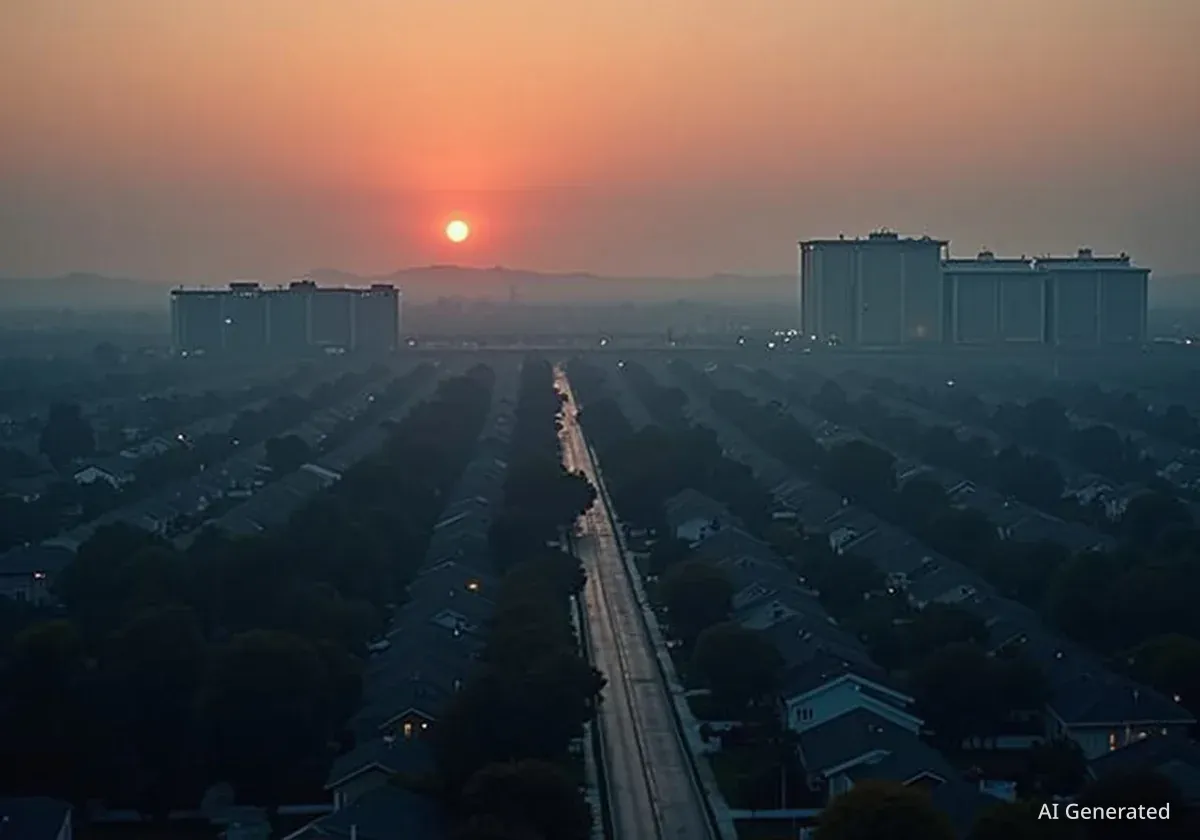Northern Virginia has become the undisputed global capital for data centers, housing a massive infrastructure that processes an estimated 70% of the world's digital traffic. As the demand for artificial intelligence and cloud computing accelerates, the region is experiencing a construction boom, with hundreds of these large facilities now operating. This growth contributes billions to the state's economy but also places significant strain on local communities, raising concerns about energy consumption, environmental impact, and the changing character of suburban landscapes.
Key Takeaways
- Northern Virginia is home to approximately 600 data centers, with communities like Ashburn and Sterling hosting over 260 of them.
- The region processes an estimated 70% of global internet traffic, making it a critical hub for the digital economy.
- The data center industry contributes $9.1 billion to Virginia's economy but requires massive amounts of electricity and water.
- Local residents are increasingly affected by constant noise from cooling systems, the visual impact of large industrial buildings, and rising electricity costs associated with the industry's energy demands.
The Epicenter of Global Data
Just outside Washington, D.C., an area often referred to as "Data Center Alley" has become the most concentrated hub of digital infrastructure on the planet. The region's dominance began in the late 1990s when America Online (AOL) established its headquarters in Dulles. This move was quickly followed by the construction of a major data center by Equinix, which laid the groundwork for the massive expansion that followed.
Today, Virginia hosts around 600 data centers, with many more under construction or in the planning stages. Two adjacent communities, Ashburn and Sterling, contain the densest concentration, with about 260 of these facilities. This cluster has created a powerful network effect, attracting technology companies from around the world.
Why Northern Virginia?
Several key factors have driven this concentration of critical infrastructure. The region offers a unique combination of advantages that are difficult to replicate elsewhere:
- Fiber-Optic Network: Decades of investment have resulted in one of the most robust and dense fiber-optic cable networks in the world, enabling high-speed data transfer.
- Energy Costs: Historically, the area has provided relatively low-cost and reliable electricity, a primary operational expense for data centers.
- Skilled Workforce: Its proximity to the nation's capital provides access to a large pool of highly skilled technology and security professionals.
These elements combined have cemented Northern Virginia's status as the physical backbone of the internet. However, the rapid and sustained growth, particularly with the rise of AI, is now testing the limits of the region's resources.
A Brief History of Data Center Alley
The foundation for Northern Virginia's digital dominance was laid decades ago. The decision by AOL to relocate to Dulles in the late 1990s was a pivotal moment. Shortly after, Equinix built one of the first carrier-neutral data centers, allowing different networks to connect efficiently. This created a powerful ecosystem that attracted other tech giants, with construction intensifying significantly in the 2010s as cloud computing became mainstream.
The Strain on Energy and Local Resources
The core function of a data center—processing and storing vast amounts of information—is an energy-intensive process. Thousands of servers operating 24/7 generate immense heat, which requires powerful, continuously running cooling systems. This dual demand for electricity to power servers and cooling units makes data centers some of the largest energy consumers in any region.
Data centers in Virginia consume a significant portion of the state's electricity. The demand is so high that utility companies are planning extensive new infrastructure, including high-voltage transmission lines and electrical substations, specifically to service these facilities.
This immense appetite for power has direct consequences for residents. The cost of building new energy infrastructure is often passed on to all customers in a service area, not just the data centers. As a result, many Northern Virginia residents have seen increases in their monthly electricity bills, effectively subsidizing the power needs of the digital economy.
Beyond electricity, water consumption is another major concern. Many data center cooling systems use large amounts of water for evaporation, placing additional strain on local water supplies, particularly during dry periods. While the industry contributes $9.1 billion to Virginia's economy, this economic benefit comes with hidden environmental and utility costs borne by the local population.
Living in the Shadow of the Cloud
For those living near these facilities, the impact is not just financial. The physical presence of data centers has fundamentally altered the character of many suburban communities. These structures are often massive, with some spanning over 100,000 square feet. One facility in Ashburn, for example, is nearly 1 million square feet in size.
Noise and Visual Intrusion
One of the most common complaints from residents is the noise. The powerful cooling systems and rooftop exhaust fans generate a constant, low-frequency hum that can be audible from nearby homes day and night. This persistent noise pollution has become a source of significant disruption for communities that were once quiet residential areas.
"At one data center I visited in Manassas, an ever-present hum generated by rooftop exhaust fans was clearly audible from nearby homes," noted photographer Stephen Voss, who has documented the area's transformation.
Visually, the buildings are often described as imposing and monotonous. These large, blockish, blue-gray warehouses are now a common sight next to schools, baseball fields, and residential neighborhoods. In Herndon, a data center looms just beyond the outfield of a youth baseball park, a tangible reminder of the industry's encroachment on community spaces.
Proximity to Historic Sites
The rapid expansion has also led to data centers being built adjacent to sensitive historical areas. In Sterling, the historic Tippet's Hill Cemetery, which contains grave markers of enslaved people dating back to the 1700s, is now surrounded by these modern industrial buildings. Similarly, visitors to the Gainesville United Methodist Church Cemetery report that the quiet atmosphere is often punctuated by the humming and construction sounds from nearby data centers.
This juxtaposition of past and future highlights the tension between preserving local history and accommodating the relentless demand for digital growth. The machinery powering our seamless online experiences has a very real and resource-intensive physical footprint, and in Northern Virginia, that footprint is reshaping the daily lives of its residents.





